The deployment of multiple AI-triage devices in radiology departments has grown rapidly, yet the cumulative impact on patient wait-times across different disease conditions remains poorly understood. This research develops a comprehensive mathematical and simulation framework to quantify wait-time trade-offs when multiple AI-triage devices operate simultaneously in a clinical workflow. We created multi-QuCAD, a software tool that models complex multi-AI, multi-disease scenarios using queueing theory principles, incorporating realistic clinical parameters including disease prevalence rates, radiologist reading times, and AI performance characteristics from FDA-cleared devices. The framework was verified through four experimental scenarios ranging from simple two-disease workflows to complex nine-disease systems, comparing preemptive versus non-preemptive scheduling disciplines and priority versus hierarchical triage protocols. Analysis of brain imaging workflows demonstrated that while AI-triage devices significantly reduce wait-times for target conditions, they can substantially delay diagnosis of non-targeted, yet urgent conditions. The study revealed that hierarchical protocol generally provides more wait-time savings for the highest-priority conditions compared to the priority protocol, though at the expense of more delays to lower-priority patients with other time-sensitive conditions. The quantitative framework presented provides essential insights for orchestrating multi-AI deployments to maximize overall patient time-saving benefits while minimizing unintended delay for other important patient populations.
翻译:暂无翻译



